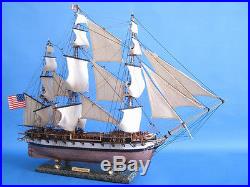
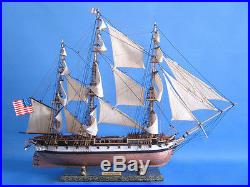
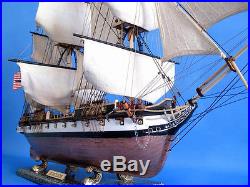
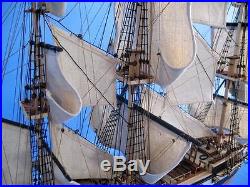
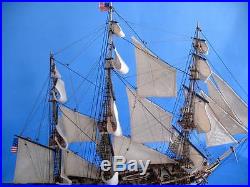
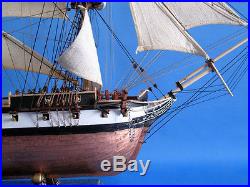

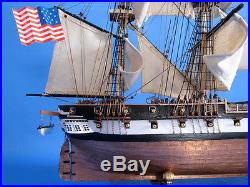
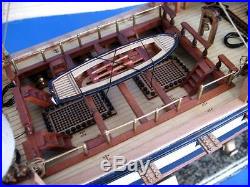
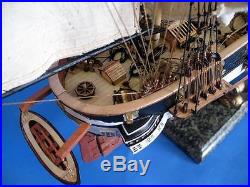
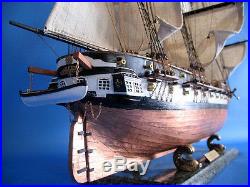


Welcome To BC Fishing World. 37″ Long x 12″ Wide x 28 High (1:100 scale). Over hundreds of hours by master artisans. Include cherry, birch, maple and rosewood. Planks used in hull construction. Accurately matches the real USS Constellation. Accurate beakhead design and scrollwork. Increased detail of deck features, cannon carriages, painting and other features. Features over 200 blocks and deadeyes. Weigh aside the bow. To deck to reduce recoil. Planked deck with nail holes. Rudder chains, cannonball racks. Solid brass cannons and metal anchors. Additional deck details such as cannon balls, barrels, etc. Masterfully stitched, heavy canvas sails hold shape and do not wrinkle. Taut rigging with varied thread gauge and color. Features four arched dolphins. Pictured with marble base. Of original plans, historical drawings and paintings as well as actual photographs ensures the highest possible accuracy. USS Constellation was a 38-gun frigate, one of the six original frigates authorized for construction by the Naval Act of 1794. She was distinguished as the first U. Navy vessel to put to sea and the first U. Navy vessel to engage, defeat, and capture an enemy vessel. Constructed in 1797, she was decommissioned in 1853. On March 27, 1794, the United States Congress passed the Naval Act of 1794, which provided for building the US Navy its first new ships: the frigates Chesapeake, Congress, Constellation, Constitution, President, and United States. Constellation was the first to be commissioned. Constellation was built at Harris Creek Shipyard in Baltimore’s Fells Point by Joshua Humphreys and launched on September 7, 1797, just as the United States entered the Quasi-War with France. He had risen to become Philadelphia’s premier shipbuilder and his shipyard was one of the busiest in Philadelphia at that time. He was appointed Master Constructor of the United States charged with the construction of 6 frigates. There were two designs one for a 44 gun frigate that would become the USS Constitution, USS President, and USS United States. The second of the two designs were 38 gun frigates USS Congress, USS Chesapeake, and USS Constellation. Both designs were controversial for their time being long on keel and narrow of beam and mounting very heavy guns. This gave the hulls a strength that other more lightly built frigates simply couldn’t match. This was done as Humphreys realized that the under populated United States could not begin to match the European states in the size of their navies. This being so, these Frigates were designed to over power other frigates and be able to run away from ships of the line. In as such they were the pocket battleship of their day. The battle started about 18 miles NE of the island of Nevis about midday when USS Constellation spotted L’Insurgente who cracked on studsails and attempted to run. L’Insurgente had recently captured USS Retaliation a schooner in November of 1796 and three weeks previous had been chased by the USS Constitution and had escaped. LInsurgentes job was that of commerce raiding; she wanted nothing to do with another warship and tried to flee Constellation. With no answer, he proceeded to chase L’Insurgente down, clearing for action and beating to quarters. Truxtun made private signals for the US Navy and again received no answer. Constellation crowded on all sail despite a rising squall that threatened to tear a sail or throw a spar. Reefing sail just long enough to weather the short squall, Constellation hardly paused but the same was not to be for L’Insurgente as her topmast snapped and slowed her to the onrushing Constellation. Captain Barreaut ordered L’Insurgente to lay up and prepared to fight. USS Constellation was outfitted with 24 pounder gun that caused her to lean too much to lee due to topweight and thus had to surrender the weather gauge to L’Insurgente. She would be refitted with 18 pounder guns in her next refit. L’Insurgente raised the French Tricolor and Captain Barreaut tried to ask for parley. Captain Truxtun refused to answer as his orders were to attack any French warship or privateer and answered when his last gun could be brought to bear. American warships of this period fired for the hull as did the British and each of the 24 pounders had been double shotted. L’Insurgente fired as per her training at the Constellation’s masts and rigging. Constellation’s masts were saved when her sail was reduced taking pressure off the damaged mast. L’Insurgente was devastated by Constellation’s 1st broadside with many dead and others deserting their guns. L’Insurgente tried to board and slowed to close but this allowed Constellation to shoot ahead and crossed her bows for a bow rake with another broadside. Constellation crossed to windward and L’Insutgente turned to follow with both crews now exchanging port broadsides instead of starboard. One of Constellation’s 24 pounders smashed through the hull of L’Insurgente; unfortunately for L’Insurgent, her 12 pounders were not equal to the same task against Constellation’s hull. Captain Barreaut had been shown one of Constellation’s 24 pound cannon balls and understood that he was in a completely unequal contest with sails down and nothing comparable to reply with many already dead and wounded. He struck colors the first major victory by an American-designed and -built warship. In February 1800 Constellation fought a night encounter with the frigate La Vengeance of 54 guns, of the La Résistance class (design by Pierre Degay, with 30 x 24-pounder guns and 20 x 12-pounder guns). La Vengeance was out weighed by the Constellation but had the heavier broadside, 559 lbs to 372 lbs. La Vengeance attempted to run and had to be chased down. An hour after sunset Constellation came into hailing range and when La Vengeance was ordered to stand to and surrender, she answered with a broadside. After an hour Constellation’s foresails failed and had to be repaired; she then overtook La Vengeance and a running battle exchanging broadsides continued. Twice the ships came close enough that boarders were called for on both ships, the 2nd occasion was quite bloody as US Marines in the Constellation shot up the deck of La Vengeance leaving her deck covered in bodies of the dead and wounded, and forcing her boarding party to seek cover. A young Lieutenant standing next to Captain Pitot of the La Vengeance had his arm taken off at this time. Constellation was victorious after a five-hour battle. La Vengeance was so holed in the hull and her rigging so cut up that she grounded outside of the port of Curacao rather than attempt to sail into port for fear of sinking. Despite a lighter broadside Captain Pitot of the La Vengeance accounted that she had fired 742 rounds in the engagement while Captain Truxtun of the Constellation reported 1,229 rounds expended. Constellation’s rigging and spars were so damaged she dare not try to sail upwind and so went to port in Jamaica. Unable to complete a refit she limped home on a jury rig. After the encounter, the Constellation’s incredible speed and power inspired the French to nickname her the Yankee Racehorse. Constellation served in the Barbary Wars against Tripoli and in the War of 1812 against Great Britain. In 1840, Constellation completed a voyage around the world, which included becoming the first U. Warship to enter the inland waters of China. In 1853, Constellation was struck and broken up for scrap at the Gosport Navy Yard in Norfolk, Virginia. At the same time, the keel was laid for what became known as the second USS Constellation. The paper “Fouled Anchors: The Constellation Question Answered”, by Dana M. Published by the Navy’s David Taylor Research Center in 1991, concludes that they are different ships. The item “USS Constellation Limited Tall Model Ship 37″ is in sale since Thursday, November 24, 2016. This item is in the category “Toys & Hobbies\Models & Kits\Boats, Ships\Wooden”. The seller is “bcfishingworld” and is located in Alhambra, CA. This item can be shipped to United States, to Canada, TH, to Mexico, MY, BR, CO, PA, JM.
- Country/Region of Manufacture: United States
- Brand: Handcrafted Model Ships
- MPN: Does Not Apply
